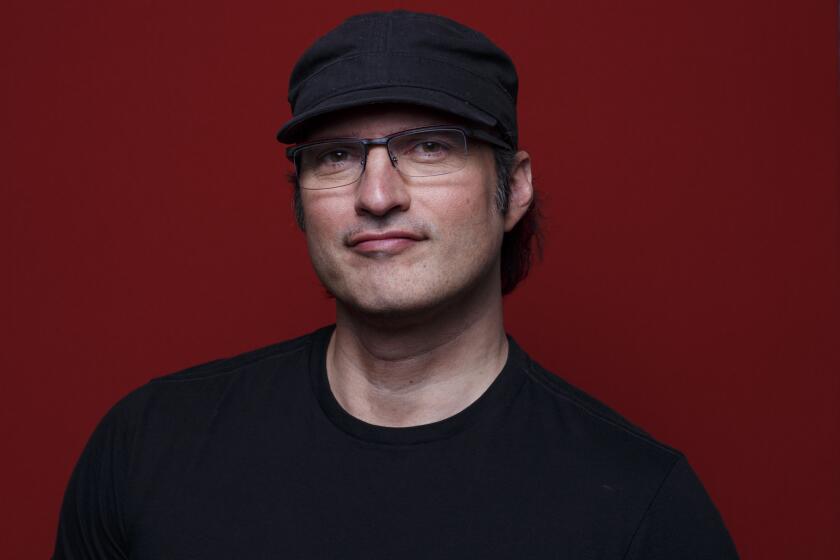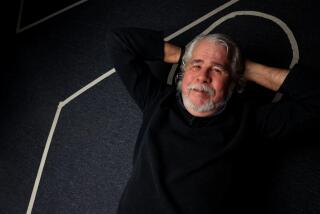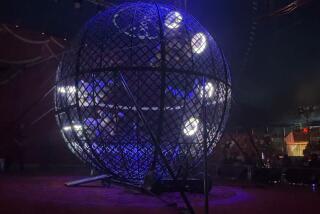Cirque du Soleil, angling for a younger audience, bets big in Vegas on ‘R.U.N’
- Share via
MONTREAL — The motorcyclist speeds up a 12-foot-tall ramp, catapulting himself more than 35 heart-stopping feet in the air. Midway through the jump, he fearlessly slips his hands off the handles, arches his back and cinematically thrusts his arms into a victory sign before safely landing 40 feet away.
For the next hour, four cyclists will zip back and forth, taking turns testing the limits of gravity. These death-defying feats are taking place not on a movie set or in a competitive arena but within the confines of the 1,463-seat theater inside the Luxor hotel and casino.
The stunt riders are rehearsing for “R.U.N,” the new Cirque du Soleil show that begins performances Thursday, Oct. 24, leading up to its official premiere Nov. 14.
As with everything in Las Vegas, the stakes are high.
Six years have passed since the Canadian theatrical company has introduced a new show on the Vegas Strip, and the time has come to find a fresh vehicle to electrify audiences. Cirque is looking for ways to attract ticket buyers who may have grown weary of acrobats, trapeze artists, contortionists and clowns. More important, the company hopes to attract and develop the next generation of audience members — younger fans, raised on video games and action movies. And that means reinvention.
“First and foremost, we wanted to have something very, very different from anything else we had done,” Chief Executive Daniel Lamarre said in July from his office overlooking the Cirque campus in Montreal.
“If you look at the movie industry, what’s working? Action movies,” he says. “We think there is a huge potential for teenagers, kids and people in their 20s who love action movies, who, when they hear that Cirque du Soleil is doing a livethriller show, will want to see it.”
Since Cirque first hit the strip in 1993 with “Mystère” at the Mirage Hotel & Casino, it has raised the bar on Vegas entertainment, pushing creative limits higher with each subsequent show: the aquatic “O,” the sensuous “Zumanity,” the battlefield antics of “Kà,” “The Beatles Love” and “Michael Jackson: One,” which are currently playing, as well as “Criss Angel Believe,” “Viva Elvis” and “Zarkana,” which have closed.
The price tag for “R.U.N” will be about $62 million, Cirque says, making it one of the company’s most expensive Vegas shows. This gamble comes at a time when tourism for the city has remained relatively stagnant, according to figures from the Las Vegas Convention and Visitors Authority. But Lamarre is undaunted.
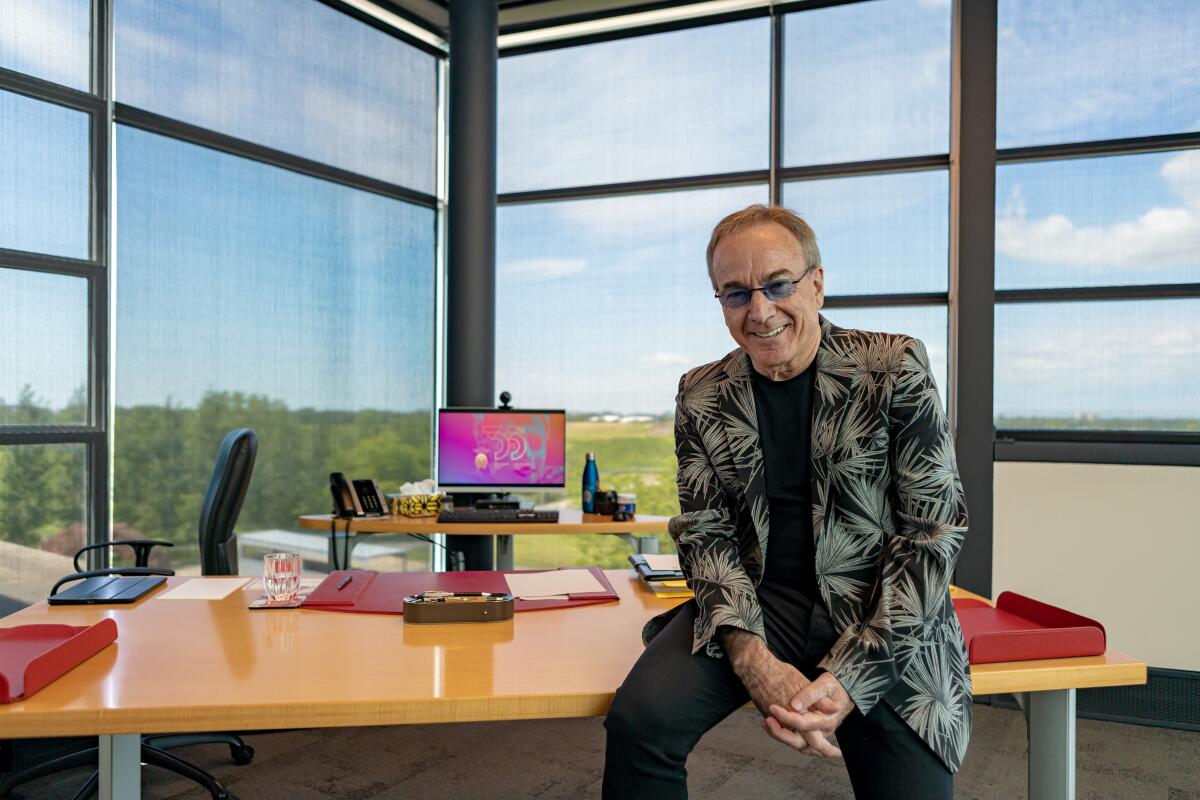
“Every show is a risk,” he says. “We’re in a risky business by definition.”
Since Cirque was founded in 1984 by street performers Guy Laliberté and Gilles Ste-Croix, Cirque has become the largest theatrical producer in the world. Its big-top touring shows have been presented in 450 cities in 60 countries. Among its newer offerings are an ice show, a touring show based on the film “Avatar,” a collaboration at Disney World featuring Disney characters and a presence at resorts and theme parks in Mexico.
In 2015, a majority interest in the company was sold to TPG Capital, a private equity firm, in a deal reportedly valued at $1.5 billion. Since then, the company has expanded its reach and diversified its holdings with the acquisition of Blue Man Group and Minnesota-based VStar Entertainment group and its Florida-based circus arts subsidiary, Cirque Productions, which produces Cirque Dreams shows. This year it added the Illusionists magic troupe to its portfolio.
In the first performance of Cirque du Soleil’s first new Vegas show in six years and its first “action thriller,” a performer gets injured.
In 2016, Cirque made a $25-million bet on Broadway with the Hollywood-themed show “Paramour.” Like other attempts at cracking the New York market — “Banana Shpeel” in 2010 and “Zarkana” the following year — “Paramour” wasn’t able to find a steady following. Most weeks, its box office take was between $800,000 and $900,000, half of its gross potential of $1.8 million, and it closed a year later after 31 previews and 366 performances. Cirque has since remounted the show in Hamburg, Germany.
Last year, an aerial performer fell to his death during a Cirque performance in Florida. It was the fourth death of a Cirque company member since 2009.
So it may be surprising that Cirque is venturing into seemingly risky territory with its newest show in Las Vegas. With “R.U.N,” Cirque is diverging from the core circus arts that made it famous in favor of a 40-person cast of stunt drivers, martial arts experts, pyrotechnic performers and freak-show artists. “R.U.N” will be heavy on video and projections, with live video shot by a camerawoman onstage integrated into the story. Much of the action will take place in the audience.
And for the first time, Cirque has brought in a writer to create a defined story line and script.
“What became very clear to all of us is that with this type of show, we want to leave less up to interpretation,” says “R.U.N” director Michael Schwandt. “We want people to understand the context of the scene: Why does he hate him? Why are they fighting right now? Why is this escalating to this point? When you have understanding of some context, it makes what you’re watching a lot better. You can root for someone.”
Filmmaker Robert Rodriguez, whose body of work includes action thrillers such as “El Mariachi,” “Sin City” and “Machete,” was tapped to write the script. Though he was busy with his own film projects, Rodriguez jumped at the opportunity to collaborate on something new.
“I’m not used to having to follow a story in a Cirque show,” Rodriguez says, “so I thought it would be a unique opportunity — a modern film noir.”
The “El Mariachi” and “Sin City” filmmaker isn’t the most logical choice to write a Cirque du Soleil show. Then again, “R.U.N” isn’t the usual Cirque show.
Like a graphic novel, “R.U.N” unfolds in chapters, each with a distinct voice and musical style.
The plan was always to put on a stunt show, Schwandt says, but the concept and packaging evolved before they settled on the story line, which revolves around two rival gangs facing off in the dark, seedy underground of Las Vegas. A wedding gets interrupted and a chase ensues. The title of the show can be read as “run” or “are you in?”
“At the end of the day, it’s a very gritty, romantic love story,” Schwandt says with a laugh. “It’s a really dark and gritty love story.”
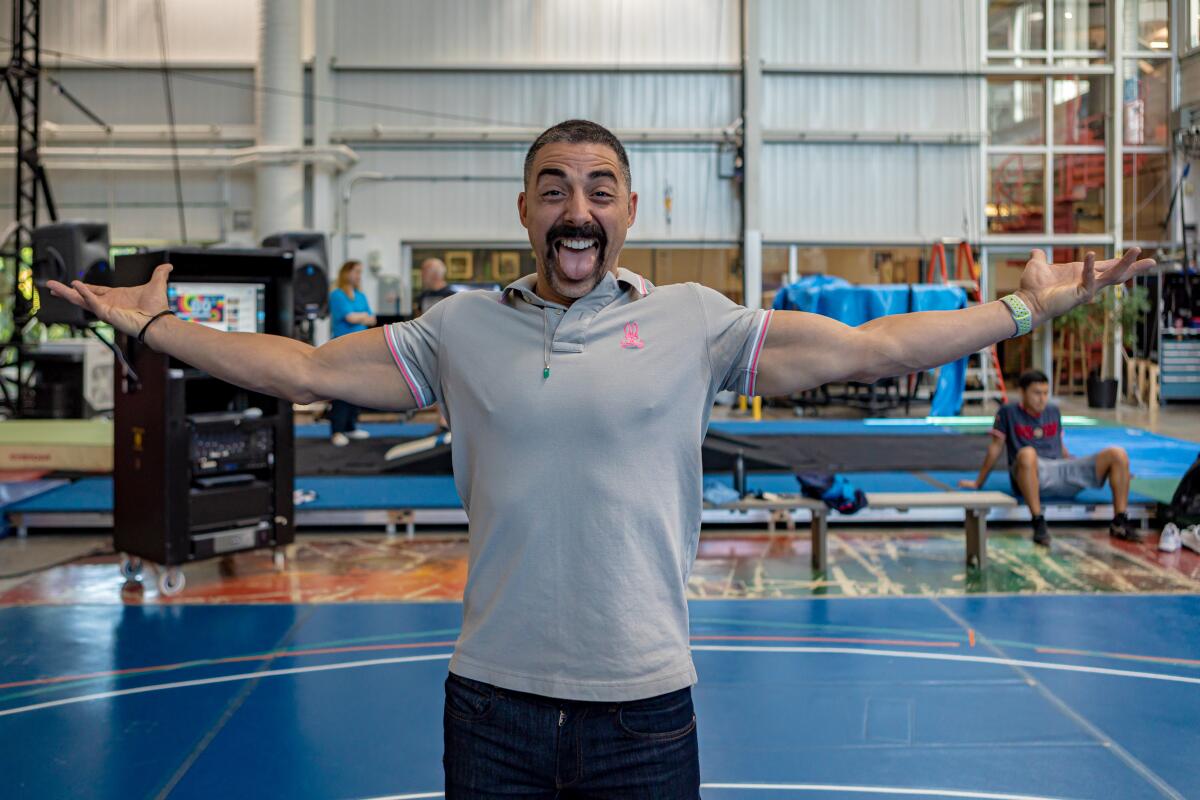
The actors don’t speak onstage. Instead, the show relies on voice-over narration, projections and other devices.
“There are times when it should feel like you’re reading the pages of a graphic novel, so things are popping up onscreen,” Schwandt says. “That’s a way for people to continue following the story without having to hear the narration all the time.”
The script significantly changed the development of the show, says Rob Bollinger, who oversees the stunt and action performances with Jean Frénette and was involved in the early development of “R.U.N.” Traditionally, Cirque builds an “acrobatic skeleton” for each show, then finds ways to develop a story around that, says Bollinger, who worked years as a film stuntman before joining Cirque as an original cast member of “Mystère.” Flipping the process gave the stunts new urgency.
“You can see somebody do a stunt, and it’s amazing by itself — but it’s just a stunt. When you put it in the context of a story — when you’re helping to tell a story or you’re helping to develop a character — then the stunt has some real meaning and purpose,” he says. “That’s the goal for this show: We’re trying to find the stunt sequences that really help to develop a character.”
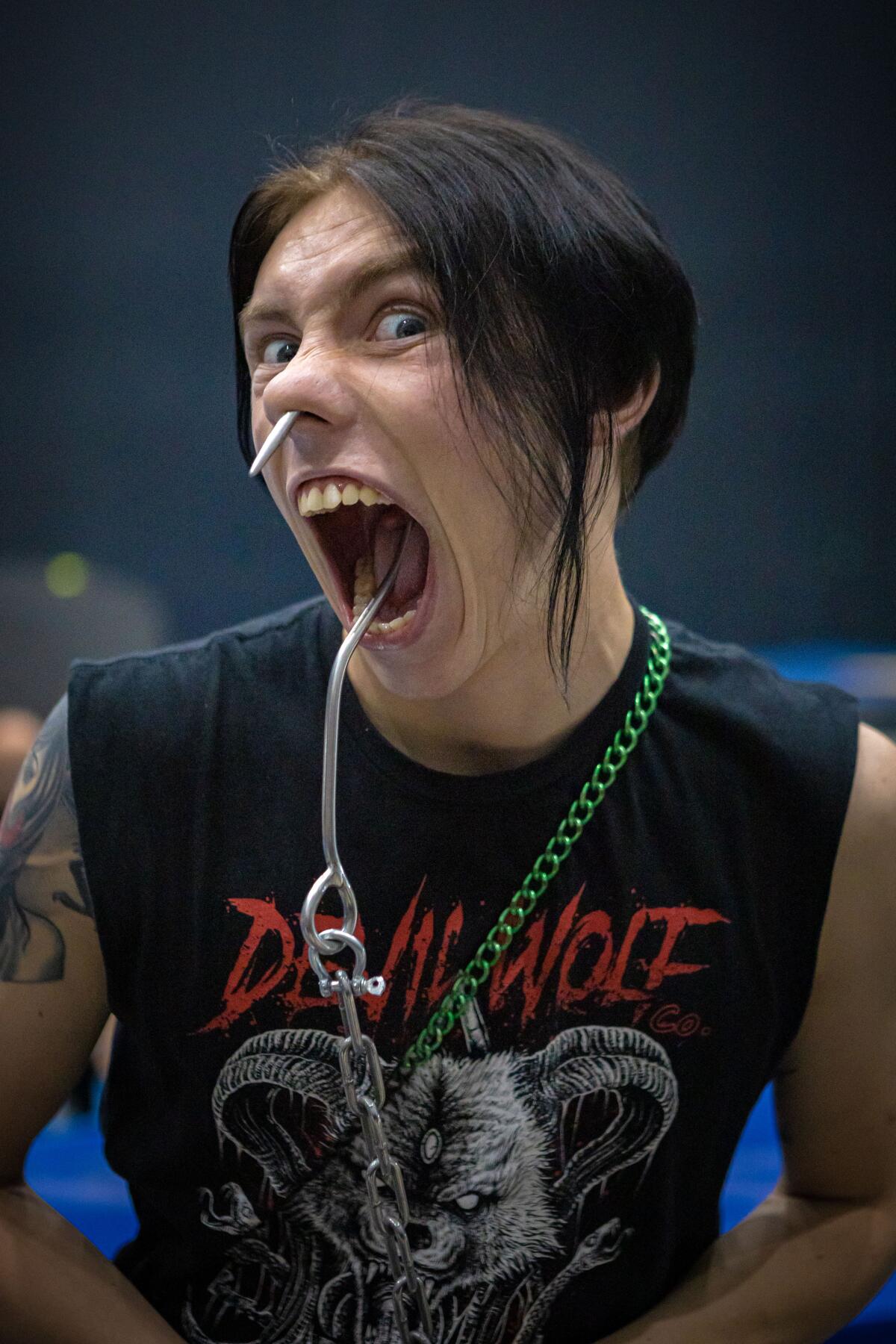
For the music, Cirque hired Tyler Bates, former lead guitarist for Marilyn Manson, who in recent years has made a name as a film and television composer, creating hard-charging scores for such features as the recent “Fast and Furious” spinoff “Hobbs & Shaw,” “300” and the “Guardians of the Galaxy” and “John Wick” films. He describes his music for “R.U.N” as “a modern amalgam of musical styles from the past 30 years.”
Bates worked closely with Schwandt to compose music that also serves character and story development.
“The music is designed to speak to the various chapters of the show,” Bates says. “The introduction of dialogue and having more of a detailed story line and the expression of a character’s inner thoughts is definitely informing the music in a significant way. The dialogue has made me rethink some things and understand some dynamics the show didn’t necessarily have imbued in it when I came onboard.”
Schwandt, a co-creator of “The Masked Singer,” is no stranger to large, complex productions. He’s overseen shows ranging from Michelle Obama’s 2013 “Let’s Move” campaign kickoff event to live performances for Nike and Reebok to concert tours for Kendrick Lamar, Katy Perry and Avril Lavigne. But juggling the many aspects of this Cirque production presented unique challenges, many of his own design.
“Oftentimes in dance, there’s chunks of people who learn the same choreography. That’s not the case here,” he says. “Every single person has to be choreographed differently. When you have 25 people fighting onstage, that’s 25 people who have to be choreographed. They’re doing completely different things. Even in scenes that have dancers, we have little synchronized choreography — and that’s by choice.”
Because of the need for precision, every movement and bit of action is carefully clocked in the 75-minute show. Bollinger has made sure even the motorcycle jumps are timed down to the second. A challenge, Schwandt says, is that many of the performers come from the stunt or martial arts world and don’t know how to count beats or read music. And some — like the motorcyclists — can’t even hear the music because of their helmets. He had to create visual cues.
In turn, Rodriguez has tweaked dialogue and Bates has adjusted the music to accommodate pyrotechnic scenes, martial arts sequences or set changes that require more stage time.
“R.U.N” is billed as an action thriller but Schwandt has avoided the temptation to go overboard with the stunts, video projections or other visuals while still providing something new for the audience to discover within each scene.
“If you do too much fighting over and over again throughout the show, it can become repetitive and you have what is called ‘fight fatigue,’” he says. “You get desensitized to it because you’re seeing so much fighting.”
He had Rodriguez write in what he refers to as “quiet moments,” laughing slyly as he notes, “Quiet doesn’t necessarily mean less impactful or less suspenseful. We have a few ‘quiet’ moments that are pretty intense.”
Though Cirque is breaking out of its mold with “R.U.N,” some of the most familiar elements of its shows will remain. The characters’ facial makeup and costumes still embody the dreamy quality of its other shows, but with darker hues and harsher lines, taking their inspiration from street gangs and futuristic action films. Tattoos, piercings and realistic scars have been added to the makeup effects.
All of the costumes are handmade in the Cirque headquarters in Montreal from fabrics that are hand-printed or hand-dyed. Even the belts, buttons and shoes are handcrafted with the show’s specific elements — such as pyrotechnics and cyclist stunts — in mind.
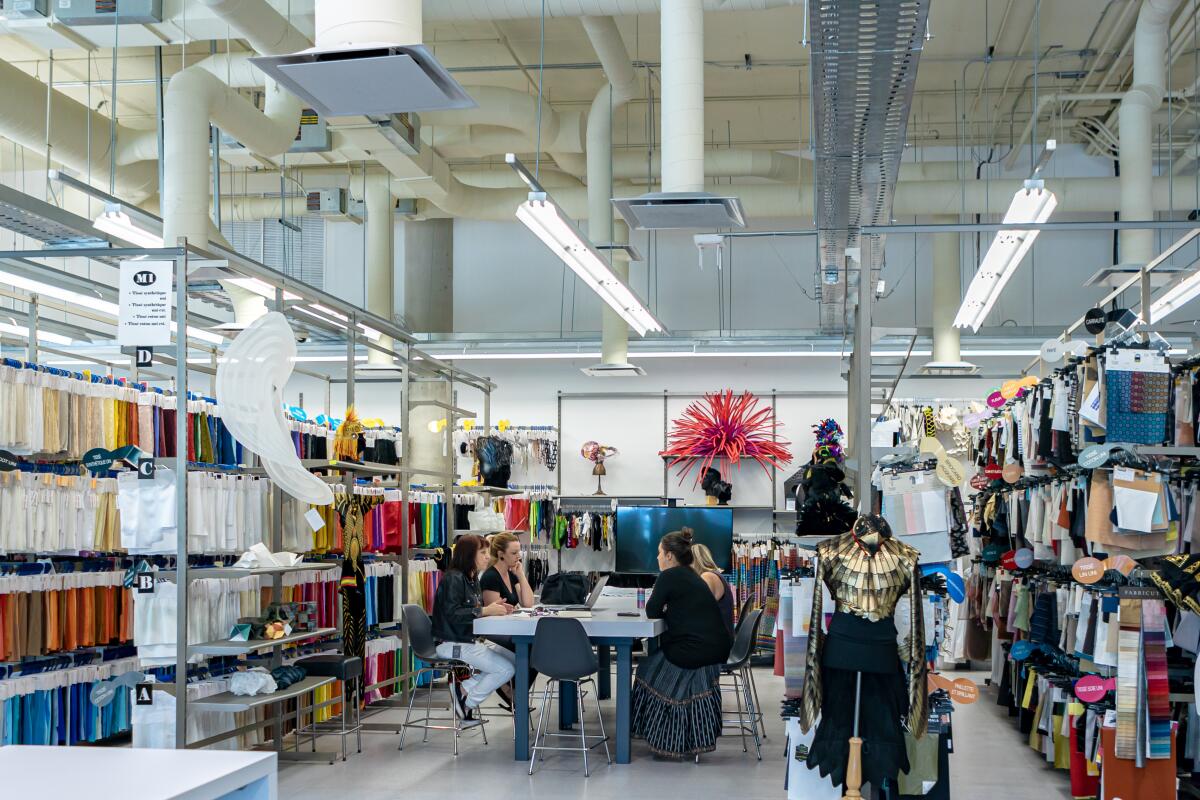
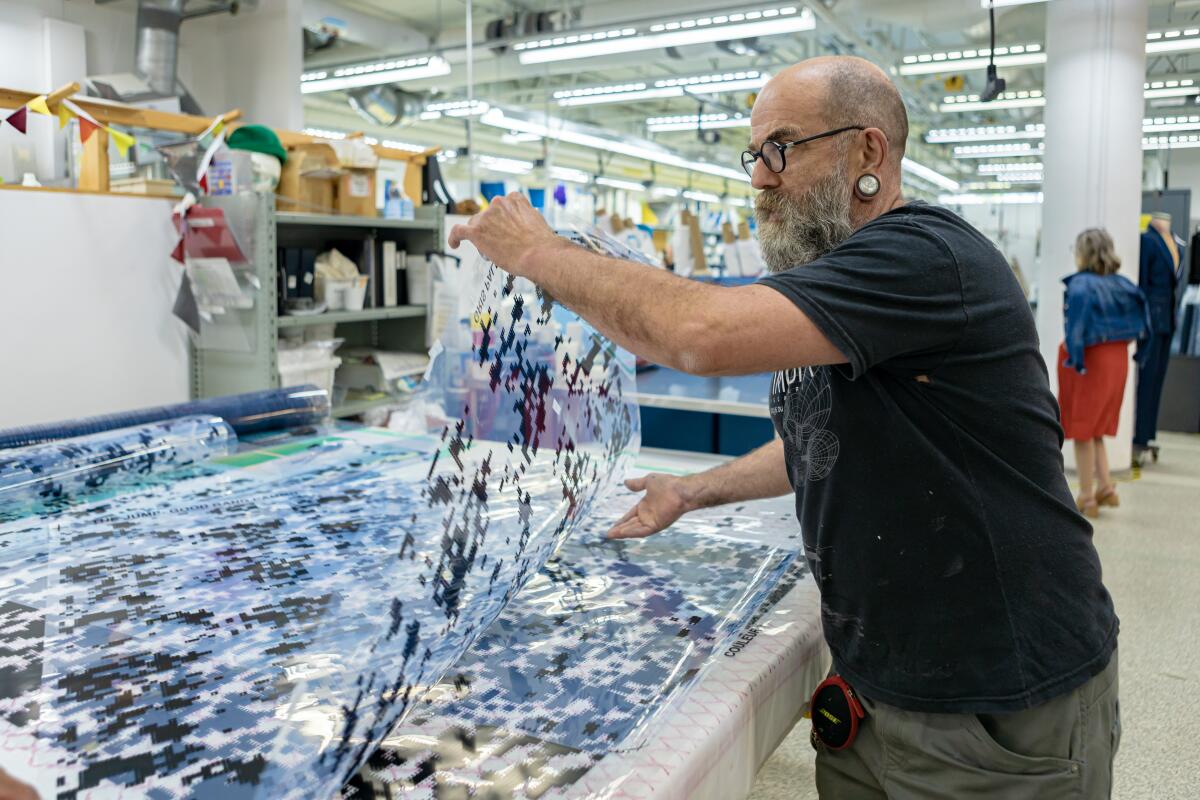
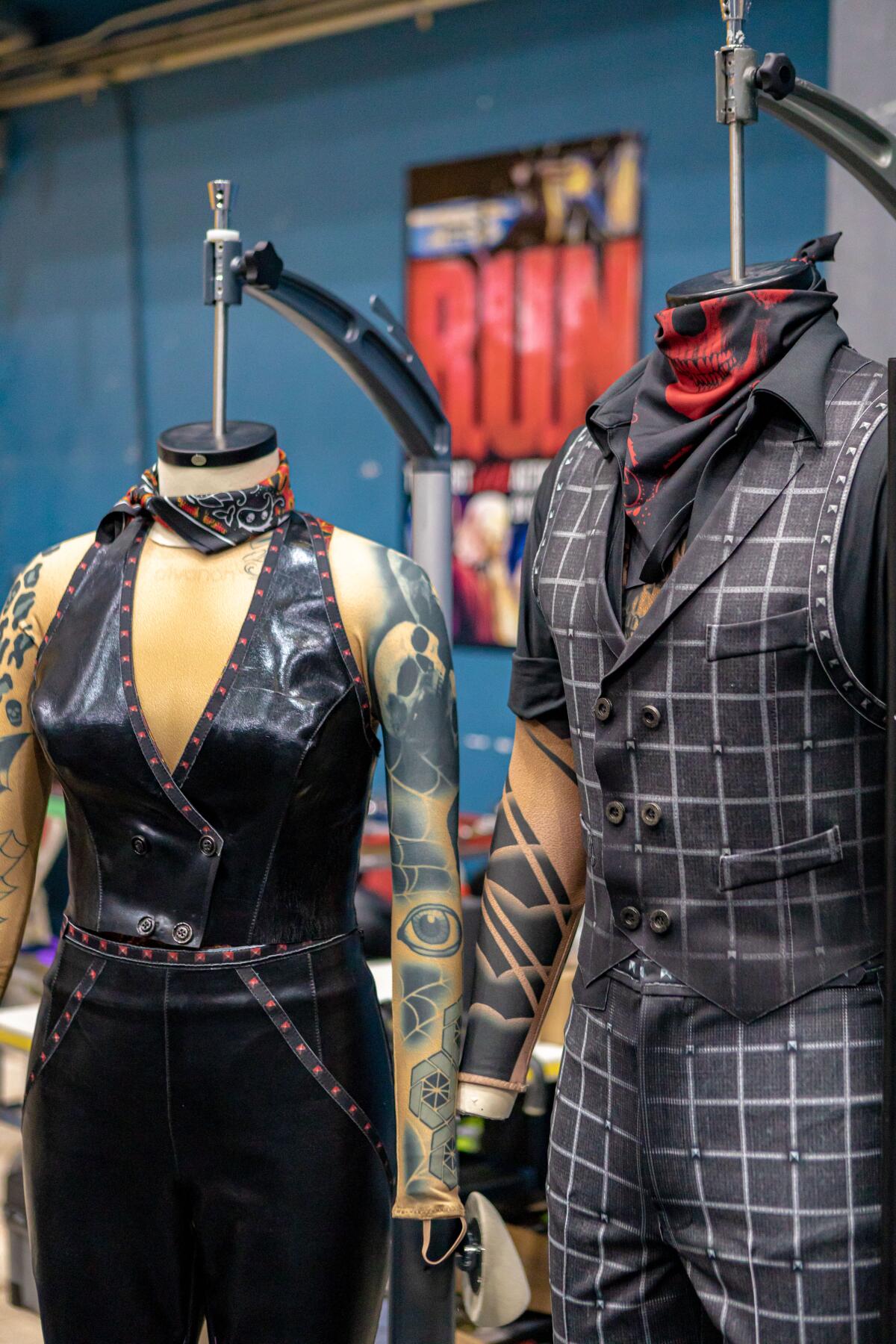
These familiar aspects are woven into the darker, cinematic feel of the new show. Audience members will begin to sense this even before they enter the theater. Set designer Bruce Rodgers has transformed 65,000 square feet of space outside the theater into a graffiti-covered, neon-lit alley scene packed with visuals and projections that ticket holders must pass through to get to their seats. No detail was too small to address. A collective of a dozen graffiti artists from Montreal was brought in for 12 days to tag the walls, layer upon layer. “A lot of people don’t get this close to graffiti in real life,” Rodgers says.
The floor is designed to resemble cracked cobblestone and concrete (“The contractors we have are trained to do perfect work, but we threw out the rule book and made them learn how to make bad asphalt”) and several lights flicker. (“All our neon signs have little glitchy things to them. We want it to feel like nothing is too perfect.”) When it came time to add a manhole cover to his street scene, Rodgers went straight to the Neenah Foundry in Wisconsin, which has manufactured millions of the iron disks seen on streets around the world.
Along the path are interactive stops including a telephone booth, a tattoo parlor and a car wreck. “Everything is designed for Instagram,” Rodgers says. “We’ve been tweaking lighting so everyone looks good when they take their selfies.”
In the weeks before the first public performances of the show, the creative team was still adapting, adjusting, testing, timing and tweaking.
“The biggest constraint has been time. We’re still dialing in the story,” Schwandt says. “That’s going to be a process all the way until we open the show. Right now, with the time we have left, everyone just wants to know what they’re doing, to lock it in. Then, once the cast gets more comfortable, they’ll want to try new things to raise the bar even more.”

More to Read
The biggest entertainment stories
Get our big stories about Hollywood, film, television, music, arts, culture and more right in your inbox as soon as they publish.
You may occasionally receive promotional content from the Los Angeles Times.
